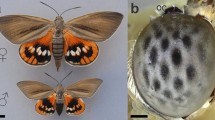Summary
-
1.
Caterpillars of the noctuid mothMamestra brassicae have six stemmata (I-VI) on either side of the head. Each stemma has seven photoreceptor cells (Fig. 1). Photoreceptor cells are spectrally differentiated into three types: UV, blue, and green (Fig. 2).
-
2.
Stemmata I and III have five green and two blue receptors; stemmata II, V, and VI have four green, one blue, and two UV receptors; stemma IV has five green and two UV receptors (Table 1).
-
3.
The spectral sensitivities of all photoreceptor cells inMamestra except for one, R4 of stemma IV, are the same as those of the anatomically equivalent cells inPapilio xuthus (Fig. 3). The R4 of IV in the former is a green receptor, while in the latter it is a blue receptor.
-
4.
The fact that the R4s of stemma IV inMamestra andPapilio differ from each other physiologically may be related to the phylogenetic distance between the two species. Support for this point of view comes from the finding that inBombyx mori, thought to be relatively closely related toMamestra, the R4 in stemma IV is a green receptor (Fig. 6) while inPieris rapae crucivora more closely related toPapilio it seems to be a blue receptor (Table 2).
Similar content being viewed by others
References
Agui N, Ogura N, Okawara M (1975) Rearing of the cabbage armyworm,Mamestra brassicae L. (Lepidoptera: Noctuidae) and some lepidopterous larvae on artificial diets. Jpn J Appl Entomol Zool 19:91–96
Barrer PM (1969) Functional studies on insect photoreceptors with special reference to lepidopteran larvae. Ph D thesis, University of London
Dethier VG (1942) The dioptric apparatus of lateral ocelli. I. The corneal lens. J Cell Comp Physiol 19:301–313
Götz B (1936) Beiträge zur Analyse des Verhaltens von Schmetterlingsraupen beim Aufsuchen des Futters und des Verpuppungsplatzes. Z Vergl Physiol 23:429–503
Hesse R (1901) Untersuchungen über die Organe der Lichtempfindung bei niederen Tieren. VII. Von den ArthropodenAugen. Z Wiss Zool 70:347–473
Hessel JH (1969) The comparative morphology of the dorsal vessel and accessory structures of the lepidoptera and its phylogenetic implications. Ann Entomol Soc Am 62:353–370
Hundertmark A (1937) Helligkeits- und Farbenunterschei- dungsvermögen der Eiraupen der Nonne (Lymantria monacha L.). Z Vergl Physiol 24:42–57
Ichikawa T, Tateda H (1980) Cellular patterns and spectral sensitivity of larval ocelli in the swallowtail butterflyPapilio. J Comp Physiol 139:41–47
Ichikawa T, Tateda H (1982) Receptive field of the stemmata in the swallowtail butterflyPapilio. J Comp Physiol 146:191–199
Kayser H, Angersbach D (1974) Action spectra for light-controlled pupal pigmentation inPieris brassicae: melanization and level of bile pigment. J Insect Physiol 20:2277–2285
Khattar P (1977) Certain factors determining visual and olfactory orientation of larvae ofPapilio demoleus L. (Lepidoptera: Papilionidae). Ph. D thesis, University of Delhi
Paulus HF, Schmidt M (1978) Evolutionswege zum Larvalauge der Insekten: Die Stemmata der Trichoptera and Lepidoptera. Z Zool Syst Evolutionsforsch 16:188–216
Suffert F, Götz B (1936) Verhalten von Schmetterlingsraupen gegenüber farbigen Flächen. Naturwissenschaften 24:815
Toh Y, Iwasaki M (1982) Ocellar system of the swallowtail butterfly larva. II. Projection of retinular axons in the brain. J Ultrastruct Res 78:120–135
Toh Y, Sagara H (1982) Ocellar system of the swallowtail butterfly larva. I. Structure of the lateral ocelli. J Ultrastruct Res 78:107–119
Truman JW (1978) Hormonal release of stereotyped motor programmes from the isolated nervous system of the cecropia silkmoth. J Exp Biol 74:151–173
Author information
Authors and Affiliations
Additional information
This was supported by Grant 510901 from the Ministry of Education to H. Tateda.
Rights and permissions
About this article
Cite this article
Ichikawa, T., Tateda, H. Distribution of color receptors in the larval eyes of four species of lepidoptera. J. Comp. Physiol. 149, 317–324 (1982). https://doi.org/10.1007/BF00619147
Accepted:
Issue Date:
DOI: https://doi.org/10.1007/BF00619147




